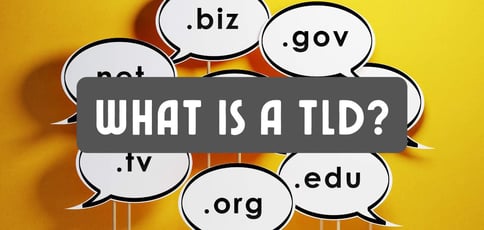
A TLD, or top-level domain, refers to the end of a domain name following the final dot. The most popular top-level domains include .com, .net, and .org, but many offer specific geographical or organizational meanings like .realtor, .de (Germany), or .law.
As part of the DNS (Domain Name System) hierarchy, ICANN (the Internet Corporation for Assigned Names and Numbers) approves and manages top-level domains. This allows for categorization and makes the internet more organized and easier to navigate.
Top-level domains impact global commerce and the entire internet by providing a structured naming system for more than 664 million global domains. In this guide, we’ll explore the inner workings of TLDs and their impact on the World Wide Web.
-
Navigate This Article:
The Purpose of TLDs
TLDs add an extra layer of branding for businesses and help guide internet users to the appropriate websites.
TLDs also assist search engines and provide credibility and identification to websites — like how the .edu domain represents an educational institute or a .gov domain indicates a governmental organization.
In addition, TLDs expand the number of domain options for new websites, as common TLDs like .com and .net become limited.
To understand the purpose of a TLD, you must first learn how the Domain Name System operates as a hierarchy for stronger organization. We’ll explain how TLDs fit into that hierarchy and have evolved over the years.
Hierarchy of Domain Names
For easier internet navigation and faster website identification, the Domain Name System operates using a multi-level hierarchy. This means each domain has several elements to guide search engines, users, and browsers.
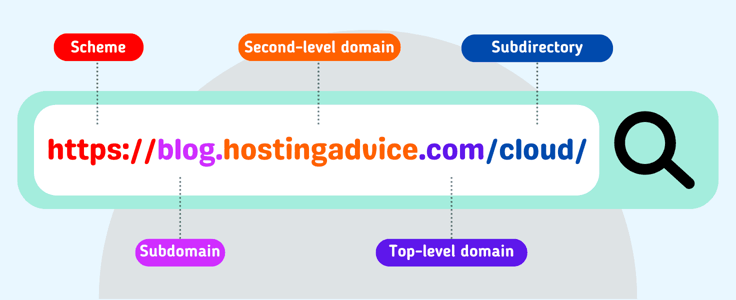
Here are the levels starting with the highest:
- Root-level domain: The root-level domain comes after “www.” and includes the TLD. For example, in www.example.com, “example.com” is the root domain.
- Top-level domains (TLDs): TLDs are identifiers after the dot, like .com, .net, or even region-based TLDs like .us or .ca.
- Second-level domains (SLDs): Everything to the left of the dot, like “example” in “example.com” is a second-level domain.
- Third-level domains: A third-level domain is an optional part of a domain that precedes the second-level domain with a dot between them. This is often called a subdomain. For instance, the “support” part in “support.example.com” is a third-level domain.
The DNS hierarchy exists to route internet traffic to the right websites, efficiently connecting domain names to IP addresses. This leads to a smoother experience for search engines and end users.
The Evolution of Domain Names
The inception of the Domain Name System in the 1980s also introduced domain names for users to access websites on a browser. With those domain names came top-level domains.
At first, only seven generic top-level domains (gTLDs) existed: .com, .net, .org, .gov, .int, .mil, and .edu. Later, several country-specific TLDs came about, like .jp for Japan and .uk for the United Kingdom.
As the internet grew, ICANN produced additional TLDs to accommodate different needs, industries, regions, and organizations. In the early 2000s, for instance, .biz and .info became available for purchase.
One of the most notable and recent changes in 2012 involved ICANN expanding into branded and custom TLDs, where a company like Disney could claim the .disney TLD or a guy named Joe could use a .joe TLD.
Types of TLDs
From generic TLDs to country code TLDs, ICANN has consistently thought of ways to allow greater access to more diverse domain names. Not all of them have the same features, though.
Some TLD types are exclusive to those in an organization or a country. Learn about the differences below.
Generic Top-Level Domains (gTLDs)
Generic top-level domains (gTLDs), the most widely used TLDs across the internet, include the original seven gTLDs and a range of newer gTLDs. Some TLDs serve very specific purposes. Others have a unique purpose, but people can purchase them for any use case.
Here are the most popular gTLDs and their uses:
- .com: This is the most popular TLD available — and anyone can buy one — but it’s technically designed for commercial businesses.
- .org: Here’s another TLD that anyone can acquire, but it’s used primarily for open-source projects, charities, and nonprofits. The idea behind the .org TLD is to present a sense of community service and organizational trust.
- .net: Various industries use the .net TLD. Its roots, however, go back to network providers like ISPs and phone companies.
- .info: Anyone can claim a .info TLD, but it’s used primarily for websites with informative content. So, you might find it on a website with learning resources or databases.
- .biz: This is a TLD that caters to commercial enterprises. It’s common with midsize businesses.
- .edu: The .edu TLD is for educational institutions like colleges, universities, and high schools. It’s mainly used in the United States, and to acquire a .edu TLD, the organization must prove that it is accredited.
- .gov: Every governmental agency in the United States uses the .gov top-level domain. No other individual or organization has access to it.
- .mil: Used for the United States military branches. No one else can use it.
- .co: Although .co has its roots as the country code for Columbia, companies across the globe use it as an alternative to the saturated .com market.
- .io: Initially used as the country code for the British Indian Ocean Territory, many tech companies like it because the TLD looks like an abbreviation for “input/output.”
As you can see, some gTLDs have specific purposes, but those purposes are sometimes ignored. Others, however, are strictly limited to certain organizations.
Country Code Top-Level Domains (ccTLDs)
A country code top-level domain, or ccTLD, represents a country. Each ccTLD has two letters.
Although it may seem counterintuitive, anyone can purchase a country code TLD, even if they have no association with the country.
A great example is how companies have adopted the Columbia TLD (.co) as a unique form of the .com TLD.
The true purpose of a ccTLD is to represent websites, individuals, and organizations with a tie to each country.
An individual who lives in France might use the .fr TLD. An American company with a presence in Canada may create a dedicated Canadian website using the .ca TLD.
Although open to anyone, most ccTLDs strengthen local branding, indicate a local presence, and even tell search engines to boost rankings for a particular website in one country.
Sponsored Top-Level Domains (sTLDs)
Sponsored top-level domains overlap with some generic top-level domains; sponsored top-level domains include the ones with restrictions on use.
The .gov TLD is reserved for government agencies in the United States, while the .mil TLD has similar restrictions for the United States military departments.
These TLDs have requirements for acquisition, such as how post-secondary educational institutions must prove accreditation for the .edu TLD. As a result, only eligible sectors and communities can gain access to sponsored TLDs.
New gTLDs
ICANN has released access to several new gTLDs over the years, expanding upon the original gTLDs like .com and .org. Some examples include .app, .shop, and .blog.
Sometimes, companies or organizations manage newer gTLDs while ICANN simply provides approval and policy creation. Automattic (the company that manages WordPress.com), for instance, actually handles the management and distribution of the .blog TLD.
These new gTLDs provide increased branding potential for businesses and organizations frustrated by the limited options available for older TLDs.
Because of their specificity, they also assist in branding and internet navigation. It’s much easier for a user and search engines to tell that a website functions as a blog with the .blog TLD as opposed to the .com TLD.
Importance of Top-Level Domains
Top-level domains serve many purposes. TLDs may seem like a few extra letters to the right of the dot, but they add an additional level of identity and uniqueness to any domain name.
From branding to geographical targeting, the importance of TLDs should not be understated.
Branding and Identity
Top-level domains serve as additional support for organizations and individuals to establish an online identity. For companies, that may mean choosing a TLD with a sense of professionalism or trust.
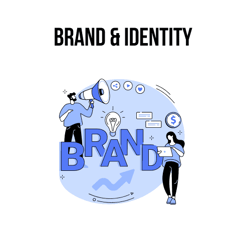
An individual, however, might crave a more personalized TLD that represents their personality, profession, name, or country. Top-level domains strengthen branding by making regular domain names more memorable, specific, and credible.
The power of a TLD is prevalent in industries like education. Institutions seek the credibility and academic authority that comes with the .edu TLD.
Alternatively, a photographer might consider using a .me, .portfolio, or .photo TLD to show the website contains a portfolio or personal résumé. This branding boost not only makes websites more memorable but can also impact SEO and marketing.
SEO and Marketing
Companies and organizations must understand the power of a top-level domain for SEO and marketing. Search engines look at the credibility of each website — content, history, backlinks, and TLDs — to establish if the website is worth ranking.

This helps identify educational and governmental organizations when the sub-level domain has requirements for use.
Some older, well-established TLDs, like .com, .org, and .net, carry a certain amount of credibility thanks to their recognizability. A user may associate a .com TLD with a reputable corporation, then look at a .biz TLD and not consider it professional.
The same goes for country code, sponsored, and new generic TLDs since they present a specific type of feeling or brand.
Because of this, companies should put careful thought into a top-level domain. It could affect search engine rankings, and users may find it perfectly relevant or completely unprofessional.
Geographical Targeting
Country code TLDs carry marketing and branding potential for many organizations, businesses, and individuals.
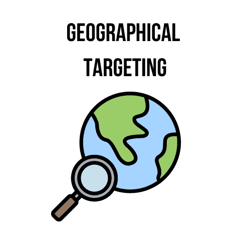
Corporations, for instance, can target specific geographical audiences by simply creating a separate website and adding a country code TLD.
A company from Germany may want to expand its presence into Mexico. In that case, it’s wise to build a dedicated website for the Mexican market and add the .mx TLD. That company benefits from the region-specific nature of the TLD.
Search engines are more likely to rank that site for country-specific searches, and users may find it more reputable and approachable, considering the country code TLD promises an experience catered to their language, culture, and regional preferences.
Trust and Credibility
Restricted TLDs carry a tremendous amount of credibility. Not only are these TLDs reserved for their appropriate use case, but they all have a long history of providing exactly what’s communicated by the TLD.
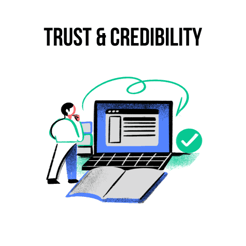
Trusted TLDs include sponsored TLDs like .gov for governmental organizations and .edu for educational institutes. Other sponsored or “controlled” TLDs refer to specific industries or companies.
The .google TLD is an excellent example. When users see that TLD, they know they’re receiving resources or services from Google. For many, that also means a certain amount of credibility, especially in the tech space.
How TLDs are Managed
ICANN has some control over every top-level domain available, but sometimes it takes a back seat role in a TLDs overall management.
In this section, we’ll talk about the role of ICANN, along with details on domain registrars and other organizations that help manage TLDs.
Role of ICANN
The Internet Corporation for Assigned Names and Numbers, or ICANN, coordinates creating and managing domain names associated with the Domain Name System (DNS).
It’s a global nonprofit organization dating back to 1998, when internet users — corporations, individuals, and governments — sought a way to provide stability and security to naming websites on the internet.
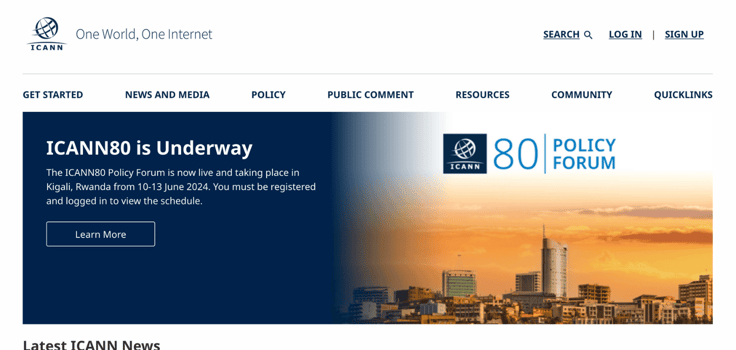
The main job of ICANN is to regulate and manage top-level domains, but depending on the TLD, it often does so as a partnership with other organizations.
ICANN oversees the creation of all new TLDs while also approving those able to sell domain names (domain name registrars). ICANN sets policies and regulations for TLD allocation, especially for TLDs with restrictions on usage.
Overall, this organization establishes a system of trust, internet reliability, and security with tasks like preventing the duplication of domain names and providing a well-structured DNS.
Registry Operators
ICANN manages several general top-level domains, but some TLDs have partner organizations that assist or take a lead role in management. These organizations are called registry operators.
For specific TLDs like .com and .org, registry operators step in to maintain the entire database of domain names using that TLD.
Registry operators secure DNS records, handle the entire technical infrastructure, and even play a role in policy enforcement. ICANN tends to write policies for these TLDs and may have a hand in enforcement, too.
Why does this happen? Some TLDs are so popular that they require an additional organization (on top of ICANN) for the most efficient management.
Other times, you’ll find that sponsored, industry, or custom domain names get managed by the organizations with a vested interest in the TLDs — like how Automattic manages .blog or The National Association of Realtors manages and enforces the .realtor TLD.
Domain Registrars
Domain name registrars act as vendors of domain names and the top-level domains that go with them. Customers purchase the right to register for a domain name.
Once they stop paying for the registration, ownership passes elsewhere. A domain name registrar must have accreditation to facilitate the registration of domain names, as approved by ICANN.
Domain registrars function as intermediaries between the registry operators and the organizations or individuals that want to register for domain names.
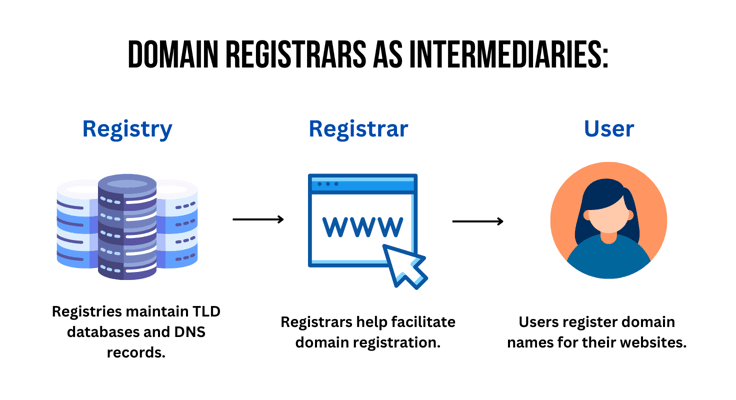
Therefore, domain registrars offer user-friendly websites with search tools to check the availability of domain names.
The end user then registers a desired domain (with TLD) and receives DNS management tools to point the domain name records to specific services (like web hosting).
Some companies only act as domain registrars, while others sell additional services and tools like website builders, web hosting, or domain privacy tools.
Regulations and Policies
ICANN governs the registration of every domain name (and its top-level domain). It does so with specific policies for each TLD. The policies cover everything from dispute resolution to domain name eligibility, renewal processes, and enforcement of rules.
Compliance with these regulations and policies results in a safe, trustworthy, and transparent internet experience. The regulations and policies set forth by ICANN prevent internet fraud, the misuse of domain names, and malicious tactics like cybersquatting.
For example, WHOIS policies require the publication of contact information for website owners. Although still susceptible to manipulation, the WHOIS policy helps foster a more transparent internet ecosystem.
Challenges and Considerations
Even with all the policies and regulations from ICANN, challenges still arise. ICANN has battled domain squatting for decades. And trademark infringement continues to be a struggle for website owners. You can, however, learn how to prevent these issues.
Domain Squatting
Domain squatting (often called cybersquatting) is targeting a brand or individual with an upcoming expiration on their domain name registration. The domain squatter tracks a domain’s expiration date, purchases the domain, and then attempts to sell it at an inflated price.

The squatter may take advantage of a brand’s trademark to sell the domain at a premium to another party. Alternatively, the squatter might hold the domain name hostage until the original owner pays an exorbitant rate for its return.
Domain squatters target high-traffic websites, popular brands, and celebrities the most. Still, there are domain squatters that simply buy up thousands of recently expired domains, which could affect small businesses and individuals.
To prevent domain squatting, put your domain renewals on autopay. All domain registrars have grace periods for brands to reclaim domain names for a time after the expiration.
If all else fails, ICANN offers what’s called a UDPR (Uniform Domain-Name Dispute-Resolution Policy), where the domain name owner can challenge and reclaim domains/TLDs that infringe on copyright regulations.
Trademark Infringement
Different from domain squatting, trademark infringement happens when another organization or individual uses a trademarked name within its domain name. Whether intentional or unintentional, this infringement causes brand confusion and legal issues.
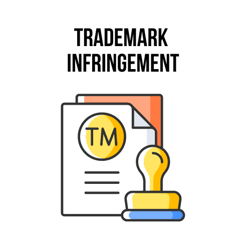
The victim could experience damage to reputation and a loss of customer trust. That’s particularly true if customers mistake an infringing website for a legitimate one.
The first course of action is to prevent trademark infringement altogether. Deploy strategies like registering all trademarks for your TLDs. This publishes your trademarks to the TMCH (Trademark Clearinghouse) so everyone sees if they may infringe on your trademark.
It’s also wise to monitor domain name registrations with names similar to yours. If you need to take legal action, use dispute resolution tactics to reclaim domains and put a stop to infringement.
You can submit a dispute through the Uniform Domain-Name Dispute-Resolution Policy.
Security Concerns
Another challenge to consider involves the various security issues related to TLDs.

You may find that some malicious parties attempt to use or mimic your domain name for malware distribution, phishing, or other cybercrimes.
To prevent misuse of your domain, implement WHOIS privacy tools so your information isn’t publicly available. You should also activate two-factor authentication for logins and use Domain Name System Security Extensions to protect your data.
Renewal and Expiry
All the risks listed above — most notably cybersquatting — may come from the expiration of your domain name registration. To avoid domain squatting, malware distribution via your domain, and other security issues, remain diligent in the timely renewal of your domains.
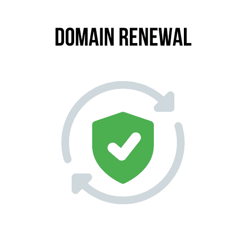
This helps prevent losing domain ownership, making it less likely to experience issues like domain squatting.
To recover expired domains, refer to your domain registrar to see how long their grace period is before the domain gets released to the public. It’s the law for all registrars to provide a grace period.
If that period has passed, you should still attempt to renew the domain. The retrieval process becomes more difficult if a domain squatter has already acquired your domain.
Options include legal action (costly) under the Anti-Cybersquatting Consumer Protection Act, filing a complaint with the UDRP (a lengthy but potentially cheaper route), or negotiating with the squatter (often the quickest option but likely expensive).
Future Trends in TLDs
With TLDs, future trends should follow what we’ve seen in the past — like with the introduction of new gTLDs. Yet, there are new developments to embrace, too: elements like internationalized domain names, blockchain-based domains, and regulatory changes.
Growth of New gTLDs
New generic top-level domains emerge every year. Custom TLDs have sped up the trend for complete control over TLDs. We expect to see the continued expansion of gTLDs so brands can choose more memorable and case-specific website addresses.
We’ve already seen new industry-focused gTLDs like .shop and .tech, along with TLDs catering to specific brands like .apple and .disney. Other corporations will surely seek TLDs that associate with their brands.
The same goes for generic TLDs for groups and industries. The collection of TLDs must consistently expand to meet the growing demands of website creators.
Internationalized Domain Names (IDNs)
IDNs, or internationalized domain names, allow for the registration of domain names in more languages. Currently, domain names only allow for Latin-based scripts.
The goal of IDNs is to offer a more inclusive environment, permitting non-Latin scripts such as Cyrillic, Arabic, and Chinese. This way, users can browse the internet using their own languages.
The overall benefits of IDNs include an enhancement in global connectivity, boosts in local market reach for corporations, and increased representation for all cultures on the internet.
Technological Advancements
Technological advancements are sure to impact the world of TLDs. Take blockchain technology, for example. The .crypto TLD already offers a censorship-resistant, decentralized domain alternative to the traditional gTLD.
We also expect to see improvements in DNS security protocols with advancements like DNS over TLS and DNS over HTTPS. Both strengthen domain security and privacy.
Other advancements to look for include AI-powered domain management, improved DNS resolution speeds (with edge computing), and more advanced predictive analytics.
Regulatory Changes
Expected regulatory changes for TLDs may involve improved cybersecurity measures, streamlined processes for reclaiming stolen domains (or those with squatters), and stricter data privacy regulations.
Initially, WHOIS regulations helped foster a more transparent internet, but website owners often want privacy, and the regulations already get avoided regularly.
With these changes, TLD management may become more expensive for registrars. In addition, we might see more complicated domain management processes. It’s essential to have international cooperation with any regulatory change.
More collaborative efforts increase trust in the domain name system, and it’s easier to handle cross-border issues when most of the world is involved.
Learning and Resources
Domain registration requires the right resources and guidance to purchase a domain, manage it effectively, and protect it from threats.
Use the following resources and tips to understand advanced domain management and to embrace the community and support available in the world of TLDs.
Getting Started with Domain Registration
Some of the best resources for domain registration come from domain registrars like Namecheap, Bluehost, and GoDaddy. You may find knowledge base articles, blog posts, or even YouTube videos to help with everything from DNS management to choosing a TLD.
You might also consider the many tech forums and online communities revolving around hosting, domain names, and technology in general. ICANN offers useful resources on its website as well.
To start choosing and registering a domain name, go to the domain registrar of your choice. Options include GoDaddy, Bluehost, HostGator, or a service through your website builder like WordPress.com, Wix, or Shopify.
Locate the page on that registrar’s website to search for the availability of domain names. Once there, type in a domain name you’d like to check. Use the Search button to view results.
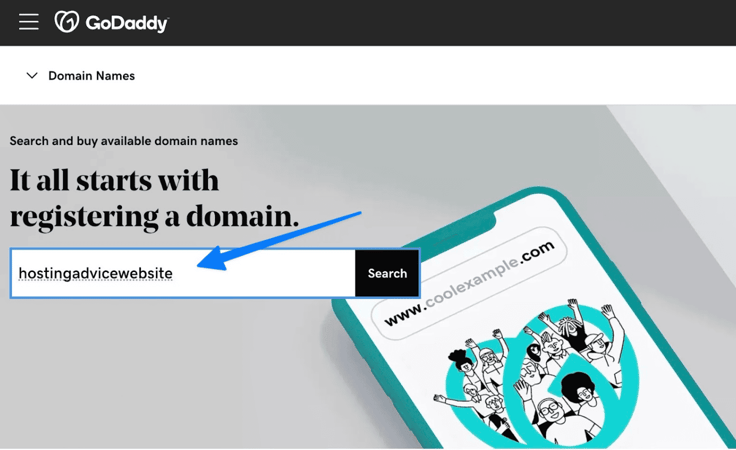
The registrar will tell you if the domain is taken. That usually means it’s used on an active website. If not, you can use a broker to contact the domain name owner and purchase it from them. This may be expensive or unsuccessful.
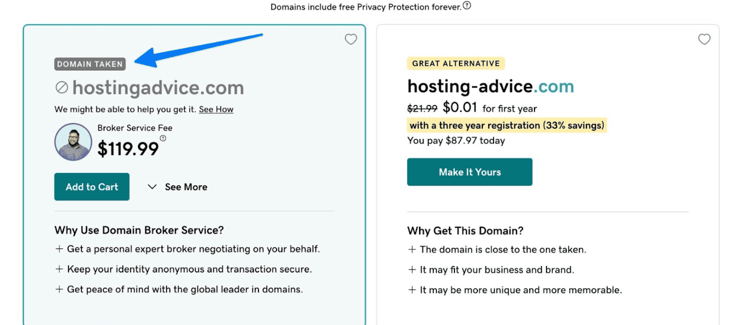
Ideally, you find a domain name that’s available (and doesn’t infringe on any trademarks).
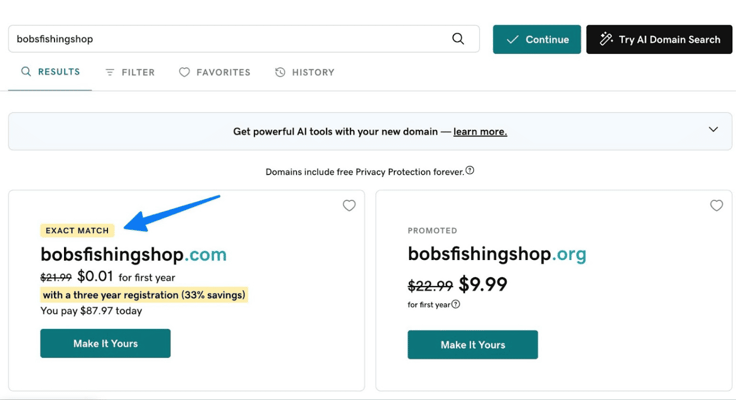
Most of the time, the registrar recommends popular TLDs first. If you can’t find the right domain or would like to consider more creatively branded top-level domains, scroll down the page to see alternatives to common TLDs like .com and .org.

Once you find the perfect domain name and top-level domain, add it to your cart and walk through the checkout process. Registration for a domain requires your contact information and credit card details.
After that, you’re sent to the domain name management dashboard to customize DNS settings and transfer your domain to another registrar.
Advanced Domain Management
If you manage a large portfolio of domains or high-value domains, consider using professional tools for DNS management. DomainTools, for instance, works well for managing large domain portfolios.
Cloudflare, on the other hand, offers a full DNS management platform with optimization and security elements.
You should also use tools for bulk management and performance monitoring. Commit to domain audits regularly and always turn on automated renewals to avoid domain squatters.
TLDs: More Than Just a Name
Top-level domains provide structure to the domain name system. Companies, organizations, and individuals benefit from the system thanks to its custom naming process and trust that comes with specific top-level domains.
TLDs also present additional information to users and search engines, especially for industry and country-specific TLDs. When choosing a top-level domain, consider that decision a crucial part of your branding process.
Make informed choices regarding a TLDs purpose, credibility, and potential for brand recognition. This way, you present your brand in the most memorable and effective way possible.







